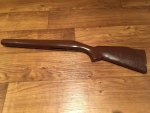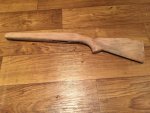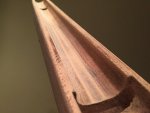I have an old Rem 788, shoots well, but the stock is ugly. so so ugly. My father bought this rifle back in the 70's I think. Ive been tossing around the idea of refinishing it myself. Well because I want to, and pulling it out of the closet brings back memories of the old man, I remember when he had my grandfathers stock refinished, and it from truck beater to prod to have it hanging on the wall piece. I don't see any value for me in keeping the stock "original" although the gun is oldish... about my age... i don't see it ever becoming any type of item where the originality would matter.
I don't really have a "well ventilated" space to work in... (stupid apartment city living)... is there a poly/stain remover that won't kill me indoors with only a window fan running?
Is that what I'm looking for a Poly/Epoxy/Stain remover?.. (I've been to several hardware stores to investigate products they sell) so far Bi-Mart had the one i think i would need , Jasco something varnish/stain remover... but I've read that gels work better than liquids because they stay in place better.
first i want to get the old coating off, then see what i have underneath... Im leaning towards sanding, then hand rubbing in a boiled linseed oil, and calling it done, but it its ugly under the glossy finish also... i just settle for some sort of paint job. and try my hand at some camp type stenciling.
ideas / suggestions / especially regarding the remover, or possibly other avenues i haven't considered yet ---
Please and thank you.
I don't really have a "well ventilated" space to work in... (stupid apartment city living)... is there a poly/stain remover that won't kill me indoors with only a window fan running?
Is that what I'm looking for a Poly/Epoxy/Stain remover?.. (I've been to several hardware stores to investigate products they sell) so far Bi-Mart had the one i think i would need , Jasco something varnish/stain remover... but I've read that gels work better than liquids because they stay in place better.
first i want to get the old coating off, then see what i have underneath... Im leaning towards sanding, then hand rubbing in a boiled linseed oil, and calling it done, but it its ugly under the glossy finish also... i just settle for some sort of paint job. and try my hand at some camp type stenciling.
ideas / suggestions / especially regarding the remover, or possibly other avenues i haven't considered yet ---
Please and thank you.







